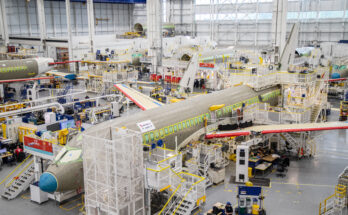Recent U.S. DoT Data Reveals Fleet of 7,309 Aircraft Flying as of Year-End 2017
by J. Kasper Oestergaard, European Correspondent, Forecast International.

Recently, the U.S. Department of Transportation released its annual Schedule B-43 Inventory database, which contains all commercial aircraft in the U.S. inventory as of year-end 2017. Some inaccuracies and inconsistencies in the raw data were identified and fixed by Forecast International by cross-checking with individual airline fleet data.
By the end of 2017, the U.S. commercial fleet consisted of 7,309 aircraft, compared to 7,130 in 2016 (+179 units, or 2.5%). The inventory was made up of 3,982 narrowbody jets (54%), 1,740 regional jets (24%), and 1,109 widebody jets (15%). The remaining 478 aircraft were turboprops, business jets, and piston-engine aircraft.
Of the 7,309 aircraft in the U.S. commercial inventory, 3,173, or 43 percent, were manufactured by Boeing, 1,446, or 20 percent, by Airbus, 1,034, or 14 percent, by Bombardier, 798, or 11 percent, by Embraer, and 472, or 7 percent, by McDonnell Douglas (now Boeing). The remaining 386 aircraft were manufactured by 13 different companies.
The most popular aircraft in the inventory remains the Boeing 737-800 with 794 units (729 in 2016), ahead of the Boeing 737-700 (585 units vs. 569 in 2016) and the Airbus A320ceo (505 units vs. 497 in 2016). In fourth place is the Boeing 757-200 (456 vs. 484), ahead of the Bombardier CRJ200 (393 vs. 385), Airbus A321ceo (350 vs. 280), and Airbus A319ceo (342 vs. 333).

In 2017, a number of new aircraft types entered the U.S. fleet, including the Airbus A320neo (17 units), the Airbus A321neo (5 units), the Airbus A350-900 (6 units), and the Boeing 737 MAX 8 (17 units). Aircraft models currently exiting the inventory include the McDonnell Douglas MD-80 series, the Boeing 757-200, and the Boeing 737 Classic (mainly dash 300s and 400s).
Many older aircraft are still active mainly as cargo haulers. For example, FedEx and UPS operate a combined fleet of 130 Airbus A300s and A310s. Also in the fleet are 108 McDonnell Douglas MD-11Fs, which is a very efficient freighter and thus coveted by the major cargo airlines. Furthermore, FedEx operates a fleet of 39 DC-10s with an age of 29-46 years; however, the airline did retire three DC-10s during 2017. It is of note that a number of small carriers still operate aircraft from the pre-jet era. The oldest aircraft in the U.S. commercial inventory is a 75-year-old 1942-built Curtiss CW-20 / C-46, a late 1930s design. Everts Air, based in Fairbanks, Alaska, operates three aircraft of this type as well as 15 Douglas DC-6s and a number of other aircraft. Other very old aircraft still in U.S. commercial service are the Convair CV-580 / CV-5800, McDonnell Douglas DC-9, Boeing 727-200, Boeing 737-200, and Lockheed L-382G Hercules.
Please feel free to use this content with Forecast International and analyst attributions, along with a link to the article. Contact Ray Peterson at +1 (203) 426-0800 or via email at ray.peterson@forecast1.com for additional analysis.
 Joakim Kasper Oestergaard is Forecast International’s AeroWeb and PowerWeb Webmaster and European Editor. In 2008, he came up with the idea for what would eventually evolve into AeroWeb. Mr. Oestergaard is an expert in aerospace & defense market intelligence, fuel efficiency in civil aviation, defense spending and defense programs. He has an affiliation with Terma Aerostructures A/S in Denmark – a leading manufacturer of composite and metal aerostructures for the F-35 Lightning II. Mr. Oestergaard has a Master’s Degree in Finance and International Business from the Aarhus School of Business – Aarhus University in Denmark.
Joakim Kasper Oestergaard is Forecast International’s AeroWeb and PowerWeb Webmaster and European Editor. In 2008, he came up with the idea for what would eventually evolve into AeroWeb. Mr. Oestergaard is an expert in aerospace & defense market intelligence, fuel efficiency in civil aviation, defense spending and defense programs. He has an affiliation with Terma Aerostructures A/S in Denmark – a leading manufacturer of composite and metal aerostructures for the F-35 Lightning II. Mr. Oestergaard has a Master’s Degree in Finance and International Business from the Aarhus School of Business – Aarhus University in Denmark.
- http://www.transtats.bts.gov/databases.asp?Mode_ID=1&Mode_Desc=Aviation&Subject_ID2=0
- http://www.fi-aeroweb.com/US-Commercial-Aircraft-Fleet.html
A military history enthusiast, Richard began at Forecast International as editor of the World Weapons Weekly newsletter. As the Internet grew in importance as a research tool, he helped design the company's Forecast Intelligence Center and currently coordinates the EMarket Alert newsletters for clients. Richard also manages social media efforts, including two new blogs: Defense & Security Monitor, covering defense systems and international issues, and Flight Plan, which focuses on commercial aviation and space systems. For over 30 years, Richard has authored the Defense & Aerospace Companies, Volume I (North America) and Volume II (International) services. The two books provide detailed data on major aerospace and defense contractors. He also edits the International Contractors service, a database that tracks all the contractors involved in the programs covered in the FI library. More recently he was appointed Manager, Information Services Group (ISG), a new unit that encompasses developing outbound content for both Forecast International and Military Periscope.




